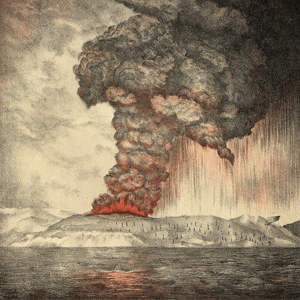 In the annals of volcanic history, few events rival the cataclysmic eruption of Krakatoa in 1883. This devastating natural phenomenon not only shook the immediate vicinity but reverberated across the globe, leaving an indelible mark on both the landscape and the collective memory of humanity.
In the annals of volcanic history, few events rival the cataclysmic eruption of Krakatoa in 1883. This devastating natural phenomenon not only shook the immediate vicinity but reverberated across the globe, leaving an indelible mark on both the landscape and the collective memory of humanity.
Nestled in the Sunda Strait between the Indonesian islands of Java and Sumatra, Krakatoa, or Krakatau, was a volcanic island known for its fiery temperament long before the events of 1883. Its location placed it within the infamous Pacific Ring of Fire, a horseshoe-shaped zone encircling the Pacific Ocean where tectonic plates collide, leading to frequent seismic activity and volcanic eruptions.
The prelude to Krakatoa’s most infamous eruption began in May 1883 with a series of increasingly violent explosions. These early signs hinted at the impending cataclysm that would soon unfold, but the full extent of the devastation was yet to be revealed.
The climactic phase of the eruptions commenced on May 20, 1883, marking the beginning of an unprecedented display of natural fury. The initial explosions tore through the island, sending plumes of ash and debris thousands of meters into the sky.
The eruptions were accompanied by colossal explosions, with volcanic material ejected high into the atmosphere. These explosions were heard over 3,000 miles away, making them one of the loudest sounds in recorded history.
The force of Krakatoa’s eruptions generated a massive pressure wave, traveling at incredible speeds across the surrounding seas. This wave, akin to a gigantic shockwave, devastated coastal communities, causing widespread destruction and loss of life.
The eruption triggered a series of tsunamis, further compounding the devastation. Towering waves, some reaching heights of over 100 feet, slammed into coastal settlements, sweeping away everything in their path and claiming countless lives.
Pyroclastic flows, superheated currents of gas, ash, and rock, cascaded down the slopes of Krakatoa, engulfing everything in their wake. Meanwhile, tephra, the volcanic debris ejected during the eruption, blanketed the surrounding areas, burying landscapes under layers of ash and pumice.
The aftermath of Krakatoa’s eruption was profound and far-reaching. The geographic effects were staggering, with entire coastlines reshaped by the force of the tsunamis and landscapes transformed by layers of volcanic ash. The global climate was also impacted, as the massive amounts of ash and sulfur dioxide injected into the atmosphere led to a temporary cooling effect, resulting in vivid sunsets observed around the world.
The human toll of the Krakatoa eruption was immense, with estimates of the death toll ranging from 36,000 to over 120,000 people. Entire communities were decimated, and countless lives were forever changed by the tragedy.
Today, Krakatoa remains an active volcano, albeit in a much-changed form since the events of 1883. Ongoing monitoring and research provide valuable insights into its behavior, but the specter of future eruptions looms large. While predictions regarding specific eruptions remain uncertain, the lessons learned from Krakatoa’s cataclysmic eruption serve as a stark reminder of the awesome power of nature and the need for continued vigilance in the face of volcanic activity.
Leave a comment